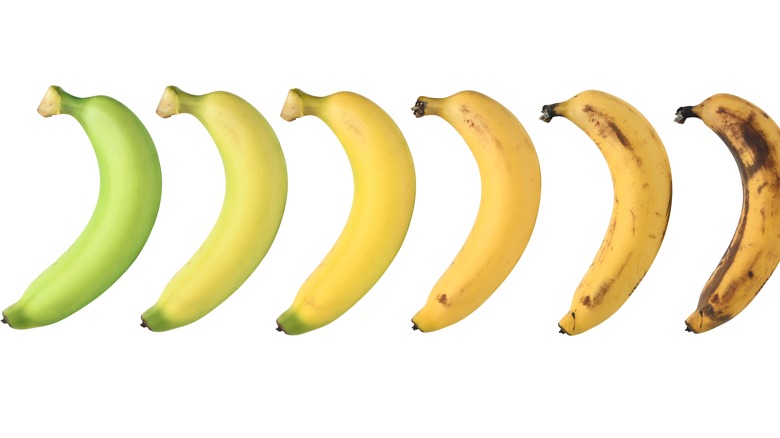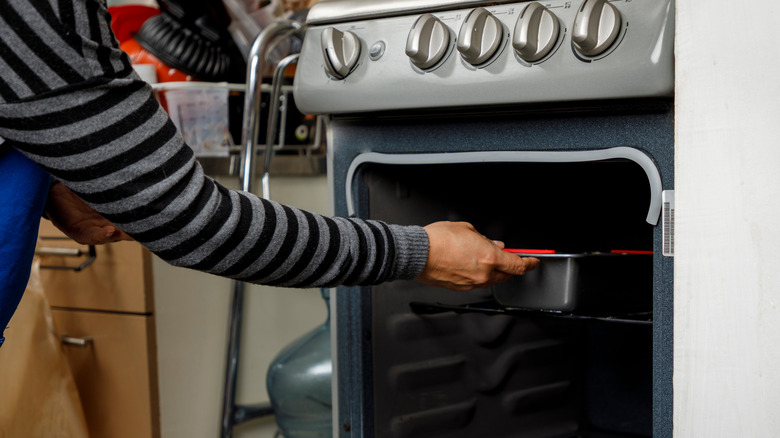7 Tricks To Make Bananas Ripen Faster
We may receive a commission on purchases made from links.
Let's set the scene. You're home; maybe you are quarantining for some reason, and perhaps you just want a delightful, no-stress baking project. Either way, the hankering for banana bread has hit, and it hit hard. You look at your bananas and, to your despair, they are perfectly yellow and firm. Woe is you! Going to the store for some old, perfectly brown, and spotty bananas seems like a fool's errand. But using under-ripe bananas just isn't going to do the trick.
When bananas ripen, their starches convert to sugar, making them sweeter. This conversion also breaks down the texture, making them easier to mash. Using overripe bananas can be a make-or-break for a successful baking project. But if you only have yellow or, heaven forbid, green bananas, what are you to do? We're here to answer just that. Here are seven ways to ripen your bananas and make them perfect for baking or snacking quickly without leaving your house.
Microwave the banana
Microwaves are great for quick and effective meal prep. Microwaves work by bouncing around microwaves that pass through the food, effectively causing the food molecules to speed up (via Britannica). The increase in molecule speed makes the food heat up. Of course, the heating isn't always even, but it sure does the trick.
Many people don't realize that microwaves can also be used to speed up the ripening process of bananas (per Microwave Meal Prep). It is one of the fastest methods around, requiring only 30 seconds, and is best for bananas intended for baking. To use a microwave to ripen a banana, simply poke the banana a few times with a fork or sharp knife, creating vents through the peel. (We don't want an exploding banana, after all. The clean up would be terrible.) Then, place the banana in the microwave and set it for 30 seconds. The banana will brown and the inside will become much softer.
A word of caution, though: Using this method in place of a more natural ripening method means not all the starches will convert to sugars, so your bananas will likely not be as sweet. But in a pinch, this method does the trick.
Pop the bananas in the oven
Similar to using a microwave, the oven can also be a fast method for aging your bananas for baking. This method does take longer than a microwave, but you can do as many bananas as your oven can hold. Plus, you don't have to worry about exploding bananas.
To age your bananas in the oven, low and slow is the name of the game (via Southern Living). Start by setting your oven to 300 degrees Fahrenheit. Next, place the bananas on a baking sheet and ensure they do not overlap. You may also want an extra layer of parchment paper between the baking sheet and banana to save yourself some cleanup time, as the bananas tend to emit a sugary liquid in the oven.
Once the bananas are in the oven, it will take about 20 minutes for them to turn black and mushy. At the 20-minute mark, you can begin to check them. If you are using this method for baking, you want the bananas to be completely black. While they may look jarring, they will give you the best texture for your baking project.
Use your air fryer
Rounding off our quick appliance-based browning methods for bananas is everyone's favorite kitchen gadget: the air fryer.
Using the air fryer has the advantage of aging your bananas quickly, without you having to heat your oven or dirty a large baking sheet. The air fryer also takes less than half the time of an oven (via Air Fryer Yum), making it the second most efficient method on this list.
To use an air fryer to age a banana, place your bananas in the air fryer (surprise, surprise). We recommend lining the bottom of your air fryer, as you will have leaking issues similar to those in the oven. Set your air fryer to 300 degrees Fahrenheit and set the timer for 8 minutes. The peel should be completely black when they are ready.
There are a few drawbacks to this method, though. First, a typical air fryer can only hold about three bananas. This amount of bananas is typically fine for a loaf of banana bread, but some recipes call for more than three bananas, which means you would have to do more than one batch of air-fried bananas. Additionally, the air fryer is not effective on bananas with any green. For those, you will just have to use one of our natural aging methods.
Put the bananas in a brown paper bag
Maybe you are planning ahead and want to make banana bread later in the week. Or perhaps you just wish for the perfectly ripe banana to snack on. Either way, the brown bag banana might just be your ticket.
Before we get into how to use the brown bag method, it is helpful to know why it is effective. When the fruit ripens, it produces ethylene gas (via BBC Good Food). Fruits do this in different quantities, with bananas making an exceptionally high amount. This gas is responsible for the banana ripening and converting the starches into sugars. It follows then that to speed up the ripening process, you just need more ethylene gas. That is where the brown bag method comes in.
It's simple: Take your bananas and place them in a paper bag for at least 24 hours. That is it. That is the method. The paper bag traps the ethylene gas, while allowing moisture to escape, causing your fruit to ripen faster — in as little as a day.
Just remember only to use paper bags. Using a plastic bag will trap moisture and ethylene gas, which will lead to an unpleasant situation.
Keep the bunch together
Sticking together isn't just for horror movies; it is also an effective method of ripening fruit! Remember above where we explained the whole "bananas give off a lot of ethylene gas" thing, and that ethylene gas was responsible for making fruit ripe? Well, this method works because of that very principle.
According to banana company Chiquita, keeping the bananas in the bunch together helps them ripen more quickly. The ethylene gas each banana produces accumulates and causes the bananas to ripen more rapidly. Simply leave the bunch of bananas together. You need to do nothing else. There is no fancy equipment required and no paper bags. Just make sure the bunch is together and let them sit for a few days.
Bunching the bananas together is a slower and more controlled method of ripening, and is ideal for bananas that you want to use for snacks. This method will work on green bananas, and gets them to their most delicious state ASAP.
Place them on top of the fridge
We have already shown how heat can be an effective method of ripening bananas, but you don't have to use a 300 degree oven or microwave to achieve a ripening effect. Instead, for a slower, more controlled method, simply place them on top of your refrigerator.
The outside of the refrigerator creates optimal conditions for raising the temperature of a banana. This may seem counterintuitive, as refrigerators are known for their cooling effect. But this is the very reason their exterior is perfect. According to Samsung, the outside of the fridge tends to feel warm due to the heat the machine gives off while refrigerating. The top surface of the refrigerator creates a slightly warmer environment, causing the bananas to ripen faster (especially if you keep them together to take maximum advantage of the ethylene gas they produce while ripening).
If there isn't room on top of your refrigerator, other options are placing them near a heater or in a particularly sunny spot in your kitchen. Just make sure they don't heat up too quickly, or you may be forced to make an emergency batch of banana bread.
Store them with other fruit
Our final method for ripening bananas comes to us from fruit giant Dole. Specifically, from their "don't" section on storing bananas. Hear us out, though. While this is something you certainly don't want to do to preserve your bananas, it is absolutely something you want to do if you need them to ripen quickly.
Dole strongly suggests against storing bananas near other fruits, specifically apples and avocados, because the presence of other fruits causes the bananas to ripen. We explored this earlier with the bunching method. Each fruit will give off its ethylene gas, which speeds up the ripening process of the other fruits around them. This would be a suitable method if you are down to your last few bananas or only want a few of them to ripen. Let the fruits party together, and when you come back, your banana should be perfectly ripe for eating. Just make sure you keep an eye on all the fruits, so none of them go too far over into rotting territory.







